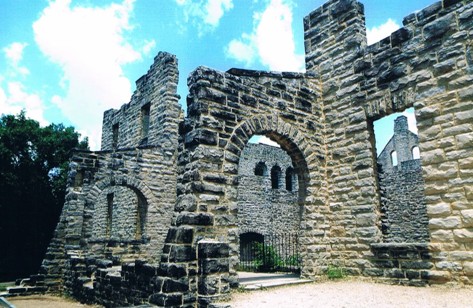2017 marks the 100th birthday of Missouri’s
State Parks. The state’s ninety-two
parks and historical sites offer great diversity in both natural and cultural landscape. The more than 150,000 acres open to the
public offer an amazing array of activities.
In addition to hiking, some destinations offer fishing, canoeing, horseback
riding, mountain biking, and two offer ATV trails. Accommodations vary by location and include
cabins, motels, lodges, and even yurts. Over
3,600 campsites are available at forty-one different parks and historic sites. Twelve parks have dining facilities. Historic sites include covered bridges, mills,
Civil War battlefields, homes of famous Missourians, cemeteries, and heritage
sites.
 |
| Deutschheim or "German Home" in Hermann. By 1860, more than half of foreign born Americans were from Germany. Deutschheim became a State Historic Site in 1978 |
 |
| This is the rear of the home, with a German four-square "kitchen garden." The style of the home is German Neoclassical. It belonged to the widow of one of the settlement's founders. |
 |
| Germans settled along the Missouri River because it reminded them of the Rhine Valley in Germany. The area became the home of the Missouri wine industry. Some of the vines are over 100 years old |
Big Spring State Park, Alley Spring State Park, and Round
Spring State Park were subsequently recognized as nationally significant and
were donated to the National Park System. The Current River and the Jack’s Fork River
are among the very few free-flowing rivers in the country. Those two rivers and the high-volume springs
and associated caverns are important natural features. In 1964 Congress authorized 134 miles of
rivers as part of the National Park’s Ozark National Scenic Riverways, the
first-ever national scenic riverway designation.
 |
| A River Otter enjoys a swim in Round Spring. In the Ozarks' springs and subterranean waters live 38 species that are found nowhere else on earth |
In 1985 the extensive work completed by the Civilian
Conservation Corps (CCC) in and for the Missouri Park System was recognized
when 247 buildings and 95 other structures located in Missouri’s parks were
placed on the National Register of Historic Places.
 |
| This picnic shelter, in Bennett Spring State Park, near Lebanon, is a wonderful example of the work done by the CCC. This structure is now nearly 75 years old |
 |
| Bennett Spring is the largest (by volume) spring in any state park, with a flow rate of over 100,000 million gallons per day. The water holds steady at 57 degrees Fahrenheit |
 |
| At Bennett Spring, the CCC built bridges, cabins, trails, roads, a post office, dining room, and the fish hatchery, as well as this dam |
 |
| The water from Bennett Spring flows into the Niangua River, which eventually flows into the Lake of the Ozarks. Bennett Springs State Park was established in 1924 |
 |
| Sandy Creek Covered Bridge at Goldman. Even after being designated a State Historic Site, the bridge continued to carry traffic on the old Hillsboro / Lemay Ferry Road until 1984 |
 |
| The Burfordville Bridge is the oldest of the four remaining covered bridges in Missouri. Construction began in 1858. It spans the Whitewater River. |
 |
| The Lodge at Echo Bluff has a stone fireplace soaring 3 stories tall. It contains 20 guest rooms, each with a balcony and a gas fireplace. The brand-new park and lodge opened in July, 2016 |
 |
| My Mom and Dad, Dorothy and Tracy, enjoying a beautiful fall day at Current River State Park. Though not quite at the century mark, in a few weeks, they will celebrate their 69th wedding anniversary. |
As part of the Centennial celebration, the Missouri Park
System made available a State Park Passport (similar to the National Park
Passport) that a visitor could have stamped when visiting each of the parks.
This is a fun activity and gets a person visiting places one might overlook. Mike and I made day trips, stopped along the
way to and from other destinations, and discovered new RV opportunities. My Mom and Dad and I have enjoyed time
together on day trips and overnights at lodges. In addition to enjoying natural and historical
sites, these park visits have allowed us to enjoy being together and appreciate
what the “Show Me State” has to offer. Through 100 years of the Fish and Game
Department, the State Park Board, and now the Missouri Department of Natural
Resources, there are plenty of fascinating Road Stories.
 |
| The Dogwood - the Official State Tree of Missouri |
 |
| The Bluebird - the Official State Bird of Missouri |
The pictures shown and the state parks mentioned in this blog are a random sampling of the parks that we've visited in my quest to fill our State Parks Passport. We've visited others, and there are others yet to be visited. Watch for more in the future.
















